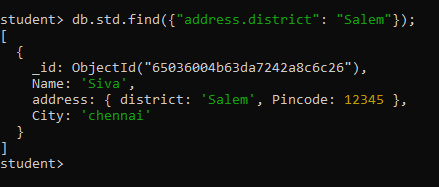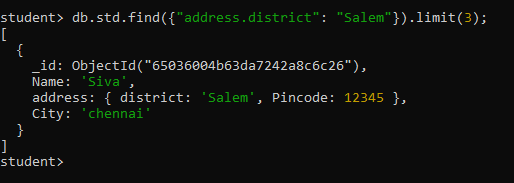Finding Documents by Object Data in MongoDB
In MongoDB, you can store nested objects (also known as embedded documents) within a document. To represent titles and keywords as nested objects within a document, you can structure your data like this
Example
[ { "Name":"Siva", "address":{ "district":"Salem", "Pincode":12345, }, "City":"chennai" }, { "Name":"Mani", "address":{ "district":"Trichy", "Pincode":12345, }, "City":"Madhurai" } ]
Find
db.std.find({"address.district": "Salem"})
The code snippet you provided is a query written in the MongoDB query language to find documents in a collection named "std" where the value of the "district" field within the "address" subdocument is equal to "Salem."
- db.std.find: This is the MongoDB "find" operation. It is used to search for documents in the "std" collection.
- {"address.district": "Salem"}: This is the query criteria enclosed in curly braces. It specifies the condition that documents must meet to be considered a match. In this case, it's looking for documents where the value of the "district" field within the "address" subdocument is equal to "Salem."
So, when you run this code against your MongoDB database, it will return all documents in the "std" collection where the "district" field in the "address" subdocument is "Salem."
Output

Count
db.std.find({"address.district": "Salem"}).count()
The code you provided is an extension of the previous code snippet. It's a MongoDB query that finds documents in the "std" collection where the value of the "district" field within the "address" subdocument is equal to "Salem," and then it counts the number of matching documents. Here's an explanation:
- db.std.find({"address.district": "Salem"}): This part of the code performs a find operation in the "std" collection. It searches for documents that meet the specified criteria, where the value of the "district" field within the "address" subdocument is equal to "Salem."
- .count(): After the find operation, the count() method is called on the result of the find operation. This method counts the number of documents that match the specified query criteria.
So, when you run this code against your MongoDB database, it will return the count (the number) of documents in the "std" collection where the "district" field in the "address" subdocument is "Salem."
Output

Limit
The code you provided is a MongoDB query that finds documents in the "std" collection where the value of the "district" field within the "address" subdocument is equal to "Salem" and then limits the result to return only the first 3 matching documents. Here's an explanation
db.std.find({"address.district": "Salem"}).limit(3)
- db.std.find({"address.district": "Salem"}): This part of the code performs a find operation in the "std" collection. It searches for documents that meet the specified criteria, where the value of the "district" field within the "address" subdocument is equal to "Salem."
- .limit(3): After the find operation, the limit() method is called on the result of the find operation. This method limits the number of documents returned in the result set to a specified number, in this case, 3.
So, when you run this code against your MongoDB database, it will return the first 3 documents in the "std" collection where the "district" field in the "address" subdocument is "Salem." If there are more than 3 matching documents, only the first 3 will be included in the result.
Output

Limit and Count
db.std.find({"address.district": "Salem"}).limit(5).count()
The code you provided is a MongoDB query that finds documents in the "std" collection where the value of the "district" field within the "address" subdocument is equal to "Salem," limits the result to return only the first 5 matching documents, and then counts the number of documents in this limited result. Here's an explanation:
- db.std.find({"address.district": "Salem"}): This part of the code performs a find operation in the "std" collection. It searches for documents that meet the specified criteria, where the value of the "district" field within the "address" subdocument is equal to "Salem."
- .limit(5): After the find operation, the limit() method is called on the result of the find operation. This method limits the number of documents returned in the result set to a specified number, in this case, 5.
- .count(): After limiting the result to 5 documents, the count() method is called. It counts the number of documents in the limited result set.
So, when you run this code against your MongoDB database, it will return the count of the first 5 documents in the "std" collection where the "district" field in the "address" subdocument is "Salem." If there are more than 5 matching documents, only the first 5 will be included in the count.
Output

Limit and Skip
The code you provided has a .skip(-1) operation, which is not typically valid in MongoDB. The .skip() method is used to skip a specified number of documents from the beginning of the result set. A negative value for .skip() is not allowed because it would not make logical sense to skip a negative number of documents.
db.std.find({"address.district": "Salem"}).limit(2).skip(-1)
- db.std.find({"address.district": "Salem"}): This part of the code performs a find operation in the "std" collection. It searches for documents that meet the specified criteria, where the value of the "district" field within the "address" subdocument is equal to "Salem."
- .limit(2): After the find operation, the .limit() method is called, which limits the result to return only the first 2 matching documents.
- .skip(-1): The .skip() method is called with a negative value of -1, which is not a valid operation. Skipping a negative number of documents doesn't make sense in the context of a database query.
If you intended to skip a specific number of documents, you should use a positive integer value with .skip(). For example, .skip(3) would skip the first 3 documents in the result set. If you have a specific use case in mind, please provide more details, and I can assist you further.
Output

MongoDB Tutorial
Learn All in Tamil © Designed & Developed By Tutor Joes | Privacy Policy | Terms & Conditions